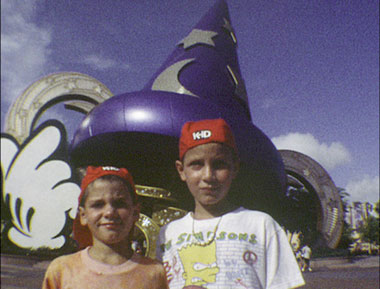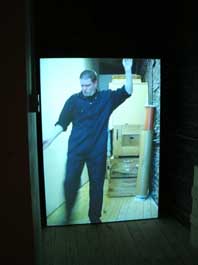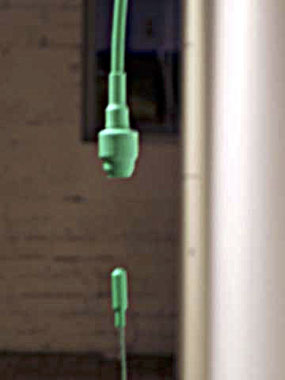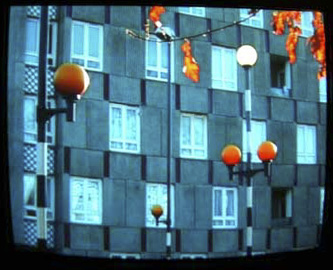It is claimed that this exhibition engages with “the action and movement of time and space," and affirms “perception and cognition as temporal processes dependent upon a dynamic amalgamation of past and present." This latter suggests that the processes of ‘perception and cognition’ are of an historical nature. However, in a show ostensibly concerned with the processes of time, there is little here that engages with the complexity of historical time, other than to show the past variously repeated in the present, the former grafted onto the latter in form only.
Similarly, the present is grafted onto the future in Jonathan Monk’s text work, which suggests a meeting on Ha’penny Bridge ten years from now. Such an insignificant rendezvous could be made for any number of reasons, but it is significant, despite its irony, because of the ‘despotic demand’ it makes upon what has not yet happened in the name of an immortal present. To claim that the future must be identical to the present is wishful thinking, finding strength in the thought of a collusive universe that addresses itself to our concerns. The structure of this thought is that of ideology. But when the passage of time may be indifferent to our ideological operations because it tends towards disorder and isolation, not ordered repetition, do we yet possess the ‘heroic’ constitution to negotiate this situation ?
Is Monk’s work a ‘witty and thoughtful’ abuse of Conceptual art’s ‘high concerns’? Perhaps: but did Conceptual art not also apply itself with wit, irony and humour to ‘the apparently insignificant moments of our life’? This work seems a little premature then in its resignation to a one-sided tactic.
 |
| Maria Marshall: 10,000 frames, 2004, film still, Super 8, colour with sound; courtesy Green on Red Gallery |
Recurrence is a feature of the spectacle, which recuperates history in an eternal present so that the future will be the same (if one was never born, how can one die?). Maria Marshall’s accelerated Super 8 film of a family trip to Disneyland shows the spectacle in all its vivid, infantile and seductive charm, displaying the same as novelty, and conflating image and reality in a caricature of authentic identity (‘it looks the same as the photograph’). But if Marshall wishes to accomplish more than a hesitant celebration of the vacuous pleasures of descending the slide only to return to the top, then this film might exploit the ‘schizophrenic’ nature of the commodity forms that it observes. The commodity endlessly defers its identity within the ‘eternal’ structure of the capitalist dynamic, but in doing so it ‘leaks meaning’. Perhaps among the ruins of this rootless and fragmented identification there might be found the means to forestall the commodity’s recreation of the world in its own image: startling and estranging permutations might be made, to deny the commodity form its spurious identity.
 |
| Tim Lloyd: Shifting, 2005, installation view, site-specific video installation; courtesy Green on Red Gallery |
Repetitive and redundant labour is the theme of Tim Lloyd’s video performance, hidden away in a rather claustrophobic storage space to the side of the main gallery. Lloyd, dressed in overalls and with the appearance of absolute concentration, moves the image of himself moving an image of himself to and fro, with no apparent purpose. An allegory of the confines of self-representation, or a reference to the unseen labour of gallery installation, perhaps: but a more apt reference might be to the recurrence of the same on the other side of the gallery walls.
 |
| Julianne Swartz: Wall embrace (green) (detail), 2004, magnets, thread, plastic, wire; courtesy Green on Red Gallery |
Julianne Swartz’s constructions also show unseen forces at play, making use of magnetism and counterweights to hold threads taught between what look like plastic casts of aerial antennae or cable plugs. Self-referential and isolated, static because irresponsive to their surroundings, these works disclose only those mundane transmissions that they carry with them. When dense networks of unseen electromagnetic currents and communications doubtless cross these surroundings, an opportunity to unearth the more extraordinary from the ordinarily imperceptible realm of technological temporality seems to have been missed.
‘Self-referential and isolated’: not unlike the human subject, which can suggest itself in the structures of temples, mandalas, debating chambers and control rooms, but which is all and none of these. Silke Schatz’s drawings suggest that with our personal recollections multiple points converge to build a delicate edifice. But in memory this subject loses the object of its thought. Schatz suggests the lost object to be the subject itself, yet it can no more give adequate representation to itself through its memories than an eye can watch itself – its freedom to find itself in its own past reveals itself as vacant.
 |
| Conor Kelly: Belisha beacons (detail), 2004, video sound installation comprising four DVDs, stereo sound; courtesy Green on Red Gallery |
Conor Kelly’s Belisha beacons develops musical rhythms and shifting levels of sound across four TV screens showing the synchronised flashing of beacons. There is an interesting interplay between sound and image, emphasised by the placement of the screens along a corridor: not finding a visual correspondence to the rhythm in one screen, one is called to the next, and so on. There are reminders here of Steve Reich’s compositions; but without responding to human activity in the process of making sound, Kelly’s work lacks the unpredictability or progressive disorder of Reich. And again, making use of a temporality that eliminates human participation in it, this time seems destined to repetition ad infinitum .
Tim Stott is an art critic living in Dublin.